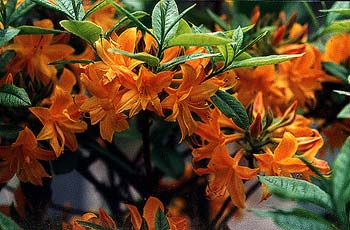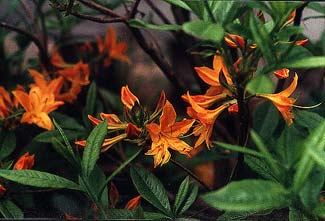 Hardy Deciduous Azalea
Hardy Deciduous Azalea
'Apricot Surprise'
"Perfumes are the feelings of flowers."
-Heinrich Heine
(1797-1856
(1797-1856
'Apricot Surprise' is a deciduous azalea derived from the native species Rhododendron prinophyllum, pollinated by an unnamed Exbury hybrid.
This is one of the "Northern Lights" series of extremely cold-hardy azaleas developed by the University of Minnesota Agricultural Experimental Station. 'Apricot Surprise' was introduced to gardening in 1987. Though on Puget Sound they will never be subjected to harsh extremes, fact is, this line of azaleas can winter through temperatures as low as minus 35 degrees! This has made the whole line popular increasingly far north, so that even gardeners of Nova Scotia or Alaska can ponder the possibilities of azaleas.
 The flowers on Apricot Surprise are smaller than on the more familiar deciduous hybrids, including other Northern Lights varieties. They are more strongly fragrant as well, one of the sweetest scents in our gardens. The pastel yellow, orange & apricot-hued unruffled funnels are set against bright green leaves. This is overall a most tasteful & elegant azalea, bright but not extreme.
The flowers on Apricot Surprise are smaller than on the more familiar deciduous hybrids, including other Northern Lights varieties. They are more strongly fragrant as well, one of the sweetest scents in our gardens. The pastel yellow, orange & apricot-hued unruffled funnels are set against bright green leaves. This is overall a most tasteful & elegant azalea, bright but not extreme.Most of the individual funnels are "singles" with interesting curling behavior, but a few of the funnels are semi-doubles . This cultivar tends to have beautifully intricate limbs even when still fairly small in size, unlike Exbury deciduous azaleas which tend to have just a few thick straight limbs when small & only gain good limb structure after they're four or five feet tall.
The primary parent R. prinophyllum (formerly R. roseum) blooms rosey-pink so in its wild form is called the Roseshell Azalea, aka Early Azalea. This species provides 'Apricot Surprise' with its pleasing limb structure even when young, its delicately formed flowers, & its ultra-hardiness for winter. The species is native from Ohio to New England to southwestern Quebec, found at high elevations. It also gave 'Apricot Surprise' its unusual fragrance of cinnamon & cloves. Neither the species nor its hybrids are fond of the heat, will not thrive in southerly climates, & require some protection from too much direct sun, especially over the roots. Ours has some shady protection from a tall narrow hornbeam, but even so it got sunburned its first year in the ground because we had an unusually hot summer. So we began hemming it in more with other plants so it is better protected.
It requires no pruning to retain its good shape. It's ten year height is 4 to 5 feet, but could in the longer run reach 7 or 8 feet. Ours is in full bloom as early as the first week of May, lasting through the first half of June.
This shrub also has lovely autumn foliage,
as can be seen on the
'Apricot Surprise' Page along the Autumn Azaleas Garden Walk.
& for more blossom photos, see the
'Apricot Surprise' Page in the Azaleas & Rhodies Blossoms Gallery
as can be seen on the
'Apricot Surprise' Page along the Autumn Azaleas Garden Walk.
& for more blossom photos, see the
'Apricot Surprise' Page in the Azaleas & Rhodies Blossoms Gallery